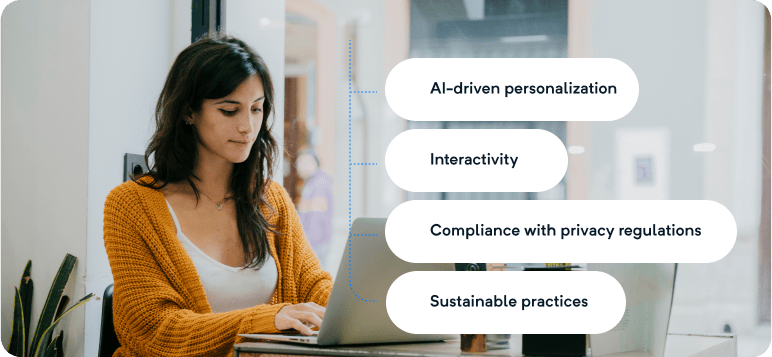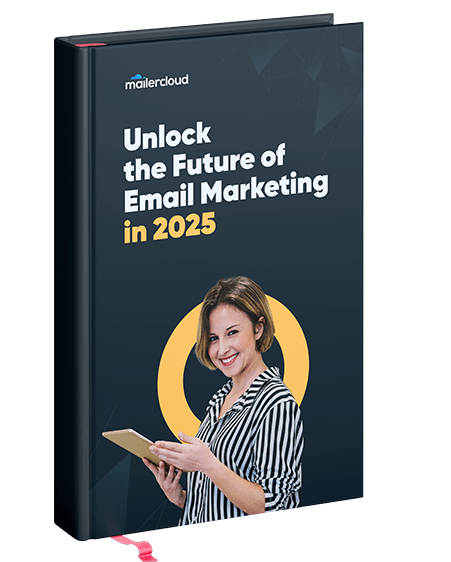E-books/Email Marketing Trends..
Email Marketing Trends in 2025
Explore the future of email marketing with in-depth analysis, and actionable strategies. Stay ahead by understanding the latest trends, tools, and best practices shaping the industry in 2025.
Inside the E-book
Boost engagement
with smart email automation.
Chapter 1:
AI-Driven Email Marketing

1.1. AI-Powered Personalization
AI has become a cornerstone in the evolution of email marketing, particularly through its ability to enable hyper-personalization. Unlike traditional methods, AI processes vast amounts of customer data, including browsing behavior, purchase history, and demographic information, to create highly tailored email content. This personalized approach ensures that every recipient receives content that resonates with their unique preferences and needs, significantly improving engagement rates.
The Mechanics of AI-Powered Personalization
AI-powered personalization leverages machine learning algorithms to analyze and predict customer behavior. By processing data from various touch points—such as website visits, email interactions, and social media engagement—AI identifies patterns that can inform more targeted marketing strategies. These patterns allow marketers to segment their audience more effectively, creating smaller, more precise groups that share similar characteristics or behaviors.
For instance, AI can recognize that a segment of customers frequently purchases outdoor gear, enabling a brand to send them targeted emails featuring the latest hiking equipment or special offers on camping gear. This level of detail ensures that the content each customer receives is not only relevant but also timely, aligning with their current interests and behaviors.
The Role of Data in Personalization
The effectiveness of AI-driven personalization is heavily dependent on the quality and quantity of data available. The more data an AI system has to work with, the more accurately it can predict customer preferences and behaviors. This data typically includes:
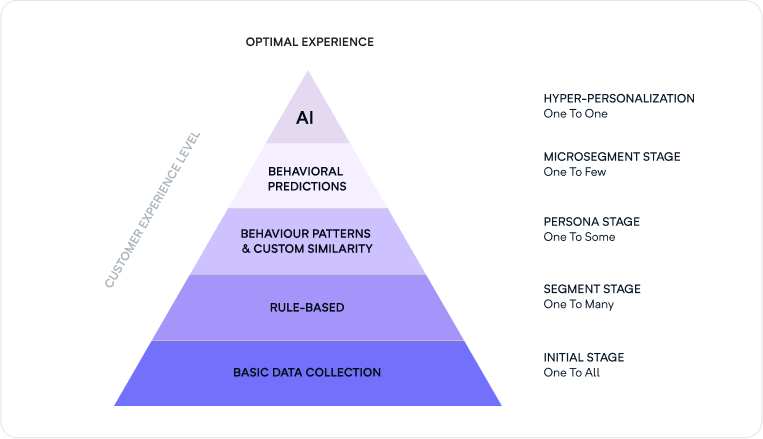
Information: Age, gender, location, etc.
Behavioral Data: Past purchases, browsing history, interaction with previous emails.
Contextual Data: Time of day, device used, location during the interaction.
Psychographic Data: Customer values, attitudes, and lifestyle.
By combining these data points, AI can build detailed customer profiles that allow for the creation of dynamic content that changes based on real-time inputs.
Real-Time Personalization

One of the most powerful aspects of AI-powered personalization is its ability to adapt content in real-time. This means that the content displayed in an email can change dynamically based on the recipient’s latest actions. For example, if a customer who frequently buys athletic wear views a new collection online but doesn’t make a purchase, the next email they receive could feature those exact items, perhaps with an added incentive like a discount code.
Real-time personalization not only increases the relevance of the email but also enhances the customer experience by providing them with exactly what they are interested in at the moment they are most likely to engage.
Benefits of AI-Powered Personalization

Increased Engagement: Personalized emails have been shown to significantly increase open rates and click-through rates (CTR). According to a study by Campaign Monitor, emails with personalized subject lines are 26% more likely to be opened.
Higher Conversion Rates: By delivering content that is more relevant to each individual, AI-powered personalization can lead to higher conversion rates. A report by Epsilon indicates that personalized emails deliver 6x higher transaction rates compared to non-personalized emails.
Customer Loyalty: Personalization helps build stronger relationships with customers by making them feel understood and valued. This can lead to increased customer loyalty and repeat purchases, which are critical for long-term business success.
Efficient Resource Allocation: AI allows marketers to automate the personalization process, freeing up time and resources that can be allocated to other critical areas of the business. This efficiency is especially valuable for companies with large and diverse customer bases.
Challenges and Considerations
While AI-powered personalization offers many benefits, it also comes with challenges. Ensuring data privacy and complying with regulations such as GDPR are critical when collecting and using customer data. Additionally, there is a risk of over-personalization, where customers might feel their privacy is being invaded if the personalization is too precise. Balancing relevance with respect for customer privacy is essential.
Future Outlook
The future of AI-powered personalization is bright, with continuous advancements in machine learning and data analytics. As AI systems become more sophisticated, they will be able to process even more complex data sets, leading to even more accurate predictions and more personalized customer experiences. This will likely include the integration of AI with other technologies such as voice assistants and augmented reality, further enhancing the personalization capabilities of email marketing.
1.2. Predictive Analytics
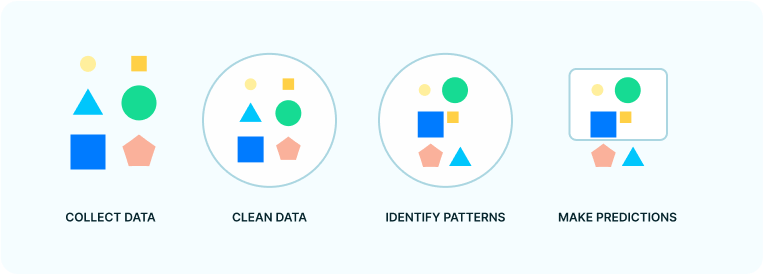
Predictive analytics is emerging as one of the most powerful applications of AI in email marketing. By leveraging historical data and sophisticated algorithms, predictive analytics allows marketers to forecast future customer behaviors and preferences with remarkable accuracy. This capability enables businesses to not only understand what their customers have done in the past but also to anticipate their future actions, thereby optimizing email content, timing, and targeting for maximum impact.
How Predictive Analytics Works
Predictive analytics in email marketing involves the use of machine learning models that analyze vast amounts of historical customer data, including past purchases, browsing history, engagement with emails, and demographic information. These models identify patterns and correlations within the data, which can be used to predict future behaviors. For example, if a customer frequently buys a particular brand or product category, the model might predict when they are likely to make their next purchase and recommend similar products or send timely offers.
These insights allow marketers to create highly personalized and targeted email campaigns that are not only relevant but also delivered at the optimal time, increasing the likelihood of engagement and conversion.
Key Applications in Email Marketing
Personalization: Predictive analytics helps marketers determine what type of content is most likely to resonate with specific segments of their audience. By understanding the preferences and behaviors of different customer groups, marketers can tailor their messages to align with what each group is most interested in, thereby improving engagement rates.
Content Personalization: Predictive analytics helps marketers determine what type of content is most likely to resonate with specific segments of their audience. By understanding the preferences and behaviors of different customer groups, marketers can tailor their messages to align with what each group is most interested in, thereby improving engagement rates.
Timing Optimization: One of the most significant benefits of predictive analytics is its ability to optimize the timing of email sends. By analyzing past behavior, such as when customers are most likely to open emails or make purchases, AI can recommend the best times to send emails to each segment, increasing the chances that the email will be opened and acted upon.
Churn Prediction: Predictive analytics can also be used to identify customers who are at risk of churning. By analyzing patterns in customer behavior—such as a decrease in engagement or purchase frequency—AI models can flag these customers and trigger re-engagement campaigns aimed at retaining them.
Case Study: Sephora

Sephora, a global leader in cosmetics retail, utilized predictive analytics to enhance their email marketing strategy. By leveraging AI to analyze customer purchase history and engagement data, Sephora was able to predict when customers were likely to run out of certain products. The company then sent personalized reminders to these customers, along with tailored product recommendations and special offers. This strategy resulted in a significant increase in repeat purchases and customer loyalty.
Benefits of Predictive Analytics
Increased ROI: By sending the right message to the right person at the right time, predictive analytics helps maximize the return on investment (ROI) for email marketing campaigns. Marketers can focus their efforts on the segments that are most likely to convert, reducing waste and increasing efficiency.
Enhanced Customer Experience: Predictive analytics allows for more personalized and relevant communication, which enhances the overall customer experience. Customers appreciate receiving offers and recommendations that align with their needs and preferences, which can lead to higher satisfaction and loyalty.
Proactive Marketing: Rather than reacting to customer behavior after it occurs, predictive analytics enables marketers to take a proactive approach. By anticipating customer needs, businesses can address potential issues before they arise, improving customer retention and lifetime value.
Challenges and Considerations
While predictive analytics offers numerous benefits, it also comes with challenges. The accuracy of predictions depends heavily on the quality and completeness of the data being analyzed. Additionally, businesses must ensure that they are using customer data in a way that complies with privacy regulations such as GDPR. Transparency with customers about how their data is being used is also crucial to maintaining trust.
Future Outlook
The future of predictive analytics in email marketing looks promising as AI technology continues to evolve. We can expect even more precise predictions as AI models become better at processing and interpreting complex data sets. Integration with other marketing channels, such as social media and SMS, will further enhance the ability of predictive analytics to deliver a seamless and personalized customer experience across all touchpoints.
1.3. AI in Subject Line Optimization

Mailercloud, a leading email marketing platform, offers AI-powered subject line suggestions as part of its suite of tools, allowing marketers to craft the most effective subject lines tailored to their audience. This feature is crucial because subject lines are often the deciding factor in whether an email gets opened or ignored. With AI, the process of creating engaging and relevant subject lines is streamlined, enhancing the overall effectiveness of email campaigns.
Subject lines serve as the first impression for your audience and play a critical role in driving email engagement. With the advent of AI, the approach to crafting effective subject lines has been transformed. AI-powered tools like those provided by Mailercloud analyze vast amounts of past performance data, including open rates, click-through rates, and conversions, to predict which subject lines will resonate most with different audience segments. This predictive capability allows for more effective A/B testing and the deployment of subject lines that are tailored to maximize engagement.
How AI Enhances Subject Line Optimization
AI utilizes machine learning algorithms to process historical email data, including previous subject lines, audience behavior, and campaign performance metrics. By identifying patterns and trends within this data, AI can generate subject line suggestions that are more likely to capture the attention of specific audience segments.
For instance, AI can assess which keywords, phrases, and tones have historically led to higher open rates for particular segments. It can also account for variables like time of day, audience demographics, and even current events, tailoring subject line recommendations to the context in which the email will be received.
The Benefits of AI-Powered Subject Line Optimization
Increased Open Rates: AI-driven subject lines are crafted based on data-driven insights, making them more likely to resonate with recipients and lead to higher open rates. This is particularly valuable in crowded inboxes where a compelling subject line is essential to stand out.
Personalization at Scale: AI allows marketers to personalize subject lines at scale, adapting them for different segments without requiring manual input for each variation. This ensures that every recipient receives a subject line that feels relevant and personalized.
Continuous Improvement: AI systems learn and improve over time. As they process more data, their predictions and recommendations become become increasingly accurate, leading to progressively better results with campaign.
Efficient A/B Testing: Traditional A/B testing can be time-consuming and resource-intensive. AI streamlines this process by predicting the likely outcome of different subject lines, allowing marketers to test more variations in less time and with greater accuracy.
Challenges and Considerations
While AI-powered subject line optimization offers many benefits, it is important to ensure that the AI tool used aligns with your brand’s voice and values. Over-reliance on AI-generated content without proper oversight can lead to subject lines that, while effective, may not accurately reflect the brand's tone or message. Regular monitoring and adjustments are necessary to maintain consistency and authenticity.
Future Outlook
The future of AI in subject line optimization looks promising, with advancements expected to include even more nuanced and context-aware subject line suggestions. As AI technology continues to evolve, it will likely integrate more closely with other aspects of email marketing, such as body content optimization and real-time personalization, further enhancing the overall effectiveness of email campaigns.
Chapter 2:
Hyper-Personalization

2.1. Dynamic Content
Dynamic content in emails, which adapts in real-time based on user behavior, is becoming a critical component of personalized marketing. This approach allows marketers to deliver highly relevant and timely messages to each recipient, significantly improving engagement and conversion rates. By displaying different content blocks to different users within the same email template, brands can ensure that every message feels personalized and directly relevant to the recipient's current needs and interests.
How Dynamic Content Works
Dynamic content is created using variables and rules that determine what content should be displayed based on specific criteria, such as the recipient's past behavior, demographics, location, or real-time actions. For example, an online retailer might send out a promotional email where the product images, descriptions, and offers vary depending on what each customer has recently browsed or purchased.
A customer who frequently buys running shoes might see a special discount on the latest running gear, while another customer who browses outdoor equipment might see a featured promotion on hiking boots.
The content within these emails can change dynamically at the time the email is opened, ensuring that the information is up-to-date and relevant to the recipient’s current context.
Key Applications of Dynamic Content
Personalized Product Recommendations: Retailers can display product recommendations tailored to the recipient’s browsing history or previous purchases, increasing the likelihood of conversion.
Location-Based Offers: Businesses can tailor their email content to reflect the recipient’s geographic location, such as promoting in-store events or offering discounts specific to their local area.
Behavioral Triggers: Emails can be customized based on specific user actions, such as abandoning a shopping cart or viewing certain products, with dynamic content encouraging them to complete their purchase.
Real-Time Inventory Updates:For e-commerce businesses, dynamic content can show real-time stock levels or indicate when a product is almost sold out, creating urgency and encouraging quicker purchases.
Case Study: Amazon

Amazon is a prime example of a company that effectively uses dynamic content in its email marketing strategy. Each email sent by Amazon is tailored to the individual recipient, featuring product recommendations based on previous purchases, browsing history, and items left in the shopping cart. The dynamic nature of these emails allows Amazon to deliver highly personalized and relevant content to millions of customers, driving higher engagement and conversion rates.
Benefits of Dynamic Content
Increased Relevance: By ensuring that each email is tailored to the recipient's specific needs and preferences, dynamic content makes emails more relevant, which typically leads to higher open and click-through rates.
Improved Engagement: Personalized content is more likely to engage recipients, leading to increased interactions with the email and brand.
Higher Conversion Rates: Dynamic content that aligns with the recipient's interests and behaviors can significantly boost conversion rates, as customers are more likely to act on offers that feel personalized.
Efficiency: Dynamic content allows marketers to create one email template that can serve multiple segments, reducing the need for creating multiple versions of the same campaign.
Challenges and Considerations
While dynamic content offers significant advantages, it also requires careful planning and execution. The success of dynamic content relies on the quality and accuracy of the data used to personalize the emails. Additionally, businesses must ensure that they have the necessary technology and integrations in place to deliver dynamic content seamlessly. Testing is crucial to ensure that dynamic elements render correctly across different email clients and devices.
Future Outlook
As AI and machine learning continue to evolve, the capabilities of dynamic content in email marketing will only expand. We can expect to see even more sophisticated personalization strategies that incorporate real-time data from multiple channels, creating an even more seamless and personalized customer experience.
2.2. Behavioral Triggered Emails
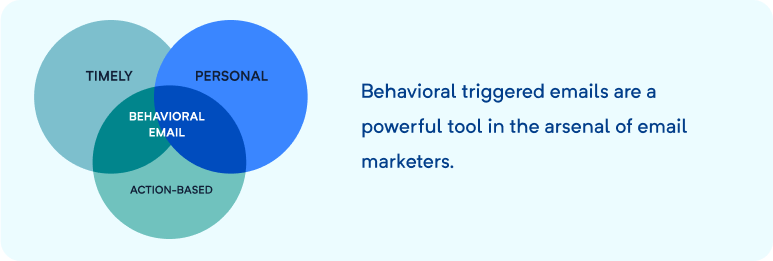
Unlike standard marketing emails, which are typically sent on a set schedule to a broad audience, triggered emails are automatically sent based on specific user actions or behaviors. These emails are finely tuned to reach users at the moment they are most likely to engage, making them significantly more effective at driving conversions and deepening customer relationships.
How Behavioral Triggered Emails Work
Behavioral triggered emails are sent in response to specific user behaviors, such as:
Cart Abandonment: If a customer adds items to their shopping cart but does not complete the purchase, a triggered email can be sent reminding them of the items and encouraging them to return and complete the transaction.
Browsing Behavior: Emails can be triggered based on the pages or products a user views. For example, if a customer spends time browsing a particular product category, an email can be sent featuring related products or special offers.
Re-Engagement Campaigns: If a user has not interacted with a brand for a certain period, a re-engagement email can be triggered to bring them back. These emails might include special offers or a reminder of what the user is missing out on.
Post-Purchase Follow-Ups: After a customer makes a purchase, a series of triggered emails can be sent to thank them, suggest related products, or request a review of their purchase.
These triggers are set up using marketing automation platforms, which monitor user activity and send the appropriate email at the right time. The personalization and relevance of these emails make them highly effective at driving action.
Case Study: Booking.com

Booking.com, a global leader in travel accommodations, effectively uses behavioral triggered emails to engage customers throughout their booking journey. For instance, if a user starts booking a hotel but does not complete the reservation, Booking.com sends a triggered email reminding them to finalize their booking. These emails often include a sense of urgency, such as notifying the user that the room is almost fully booked or offering a limited-time discount.
This strategy has proven to be highly effective for Booking.com, significantly reducing cart abandonment rates and increasing overall bookings. By reaching out to customers at the exact moment they need a nudge to complete their purchase, Booking.com ensures that they capture sales that might have otherwise been lost.
Benefits of Behavioral Triggered Emails
Higher Engagement Rates: Behavioral triggered emails are highly relevant to the recipient's current actions, making them more likely to be opened and engaged with compared to standard marketing emails.
Increased Conversions: By targeting users at the moment of decision-making, these emails can effectively drive conversions, whether it's completing a purchase, signing up for a service, or re-engaging with the brand.
Improved Customer Experience: Triggered emails contribute to a more personalized and timely communication strategy, enhancing the overall customer experience. When customers receive content that aligns with their behavior, they are more likely to view the brand favorably.
Efficient Use of Resources: Because these emails are automated, they do not require ongoing manual effort, allowing marketing teams to focus on other strategic initiatives.
Challenges and Considerations
While behavioral triggered emails offer many advantages, there are some challenges to consider:
Data Privacy: With the increasing emphasis on data privacy and regulations like GDPR, it is essential to ensure that the data used to trigger these emails is collected and used in compliance with legal requirements.
Over-Personalization: While personalization is generally beneficial, there is a fine line between being helpful and being perceived as intrusive. It's important to strike the right balance to avoid alienating customers.
Technical Setup: Implementing behavioral triggers requires a robust marketing automation platform and a clear understanding of customer journey mapping. Proper setup and testing are crucial to ensure that triggers work as intended.
Future Outlook
As AI and machine learning technologies continue to evolve, the capabilities of behavioral triggered emails will expand. We can expect even more sophisticated triggers based on real-time data and predictive analytics, allowing for even more personalized and timely communications. This evolution will make behavioral emails an even more critical component of a successful email marketing strategy.
2.3. Real-Time Personalization
Real-time personalization is a cutting-edge approach in email marketing that involves delivering content that is instantly relevant to the user’s current behavior, context, and environment. This method leverages live data to ensure that the information presented is as up-to-date and pertinent as possible, creating a more engaging and responsive experience for the recipient. Real-time personalization is particularly effective in time-sensitive scenarios, such as flash sales, limited-time offers, or when immediate action is required.
How Real-Time Personalization Works
Real-time personalization utilizes data from various sources, including browsing history, geographic location, device usage, and real-time user actions. By integrating this data into the marketing automation platform, marketers can create emails that adapt dynamically as they are opened. This means the content can change depending on the exact time or location when the email is accessed, or based on the recipient's most recent interactions with the brand.
For instance, if a user opens an email about a flash sale on their mobile device while near a physical store, the email could dynamically update to include a map to the store, along with a countdown timer showing how much time is left in the sale. Alternatively, if the email is opened after the sale has ended, the content could change to reflect the new status, offering alternative products or discounts.
Benefits of Behavioral Triggered Emails
Dynamic Pricing: Retailers can use real-time data to offer personalized pricing or discounts based on the user’s browsing behavior or location. This can be especially effective during flash sales or limited-time promotions where urgency is key.
Location-Based Offers: If a user is near a physical store, the email content can update to include relevant store information, such as directions, store hours, or in-store exclusive offers.
Product Availability: Emails can dynamically update to show the most current stock levels or notify customers when a product is back in stock. This can be crucial for driving conversions, especially when dealing with popular or limited-quantity items.
Behavioral Triggers: Content can be personalized based on the user’s recent behavior, such as products viewed or added to the cart, providing tailored recommendations or reminders.
Case Study: Spotify

Spotify, the global music streaming service, is known for its sophisticated use of real-time personalization in its email campaigns. One notable example is their “Your Year in Music” campaign, which provides users with personalized summaries of their listening habits over the past year. The email content is dynamically generated based on real-time data from the user’s listening history, including their most-played songs, favorite artists, and genres. This highly personalized approach not only engages users but also encourages them to share their unique listening summaries on social media, driving further engagement and brand loyalty.
Benefits of Real-Time Personalization
Enhanced Relevance: Real-time personalization ensures that the content a user sees is directly relevant to their current situation, making it more likely to resonate and drive action.
Increased Engagement: Emails that adapt to the user’s behavior and context in real-time are more engaging, as they provide the recipient with information or offers that feel immediate and urgent.
Higher Conversion Rates: By delivering timely and contextually relevant offers, real-time personalization can significantly boost conversion rates, particularly in scenarios where quick decision-making is encouraged.
Improved Customer Experience Real-time personalization helps create a more seamless and intuitive customer experience by delivering content that is always up-to-date and tailored to the user’s current needs.
Challenges and Considerations
While real-time personalization offers significant advantages, it also comes with challenges:
Data Integration: Successful real-time personalization requires the integration of various data sources and systems. Ensuring that this data is accurate and up-to-date is crucial for delivering the right content at the right time.
Privacy Concerns: With the use of real-time data, it’s essential to ensure that customer privacy is protected and that data is used in compliance with regulations like GDPR.
Technical Complexity: Implementing real-time personalization can be technically complex, requiring advanced marketing automation platforms and skilled personnel to manage and optimize the process.
Future Outlook
As technology continues to advance, real-time personalization will become increasingly sophisticated, integrating more data sources and allowing for even more precise and timely content delivery. The future of email marketing will likely see real-time personalization becoming a standard practice, with even greater emphasis on delivering content that feels immediate, relevant, and valuable to the recipient.
Chapter 3:
Interactive Emails

3.1. Gamification and Interactivity
In the evolving landscape of email marketing, interactivity has become a powerful tool for capturing user attention and driving engagement. By incorporating interactive elements such as polls, quizzes, and gamified experiences within emails, marketers can create a more engaging and personalized experience for recipients. These interactive features not only make emails more engaging but also provide valuable insights into customer preferences and behaviors, which can be used to refine future marketing strategies.
How Gamification and Interactivity Work in Emails
Polls and Surveys: Embedding polls or surveys within an email allows recipients to provide immediate feedback or express their preferences with a single click. This type of interactivity is highly engaging and can be used to gather valuable data on customer opinions, product preferences, or satisfaction levels.
Quizzes: Quizzes are a fun and interactive way to engage users. They can be used to help users discover products or services that suit their needs, learn more about a topic of interest, or simply enjoy a brief moment of entertainment. The results of these quizzes can be used to personalize follow-up communications, making them more relevant and targeted.
Gamification Elements: Gamified emails incorporate elements of game design, such as point scoring, leaderboards, or reward systems, to encourage user participation. For example, a retailer might create an email campaign where customers earn points for each action they take (like clicking a link or making a purchase), with rewards available for reaching certain point thresholds.
Interactive Product Displays: Allowing users to interact with product displays within an email—such as rotating a product image, zooming in on details, or swiping through different color options—can enhance the shopping experience and increase the likelihood of a purchase.
Case Study: REI

Outdoor retailer REI successfully used interactive quizzes in their email marketing strategy to engage customers and drive sales. In one campaign, they sent an email featuring a "Find Your Perfect Hiking Boot" quiz. The quiz asked users questions about their hiking preferences, such as terrain type and distance, and then recommended the best boots for their needs. This interactive approach not only increased email engagement rates but also led to a significant boost in conversions, as users were more confident in their purchasing decisions.
Benefits of Gamification and Interactivity
Increased Engagement: Interactive elements make emails more engaging by encouraging recipients to actively participate rather than passively read. This leads to higher click-through rates and longer time spent interacting with the email content.
Valuable Data Collection: Every interaction within an email provides marketers with valuable data on customer preferences and behaviors. This data can be used to segment audiences more effectively and deliver more personalized content in future campaigns.
Enhanced Customer Experience: Interactive emails provide a more dynamic and enjoyable experience for recipients, which can enhance their perception of the brand and lead to increased loyalty.
Higher Conversion Rates: By making the email experience more engaging and tailored to the recipient's needs, interactive elements can lead to higher conversion rates, whether the goal is to complete a purchase, sign up for a service, or participate in a promotion.
Challenges and Considerations
While the benefits of interactive emails are clear, there are also challenges to consider
Technical Compatibility: Not all email clients fully support interactive elements, which can lead to inconsistent experiences for recipients. It’s important to test emails across different platforms and devices to ensure that they render correctly.
Increased Complexity: Designing and implementing interactive emails requires more resources and expertise than standard emails. This includes ensuring that the interactive elements are intuitive and easy to use.
Data Privacy: Collecting data through interactive elements must be done in compliance with data privacy regulations, such as GDPR. Transparency with users about how their data will be used is essential.
Future Outlook
As email technology continues to advance, the use of interactivity and gamification within emails is expected to grow. We can anticipate more sophisticated interactive features, including augmented reality (AR) elements and even more seamless integration with other digital channels. These advancements will continue to make email a powerful tool for driving engagement and achieving marketing objectives.
3.2. AMP for Email

AMP (Accelerated Mobile Pages) for email is a technology that allows for richer, more interactive experiences directly within the email itself. This technology, supported by platforms like Mailercloud, enables users to perform actions such as RSVPs, form submissions, or browsing products without leaving their email client. By integrating these interactive capabilities, AMP for email significantly enhances user engagement and provides a more seamless, effective user experience.
How AMP for Email Works
Mailercloud, along with other leading email marketing platforms, offers the ability to create and send AMP-powered emails. These emails are built using AMP HTML, a framework that allows for dynamic content within the email itself. The interactive elements enabled by AMP for email include:
Forms and Surveys: Recipients can fill out forms, complete surveys, or submit feedback directly within the email, streamlining the process and increasing the likelihood of user participation.
Product Carousels: AMP emails can include product carousels, allowing users to swipe through items, view details, and make selections—all within the email.
Real-Time Data: Content within an AMP email can update in real-time, ensuring that recipients always see the most current information, such as live inventory levels or pricing.
RSVPs and Appointments: Users can RSVP to events, book appointments, or manage their schedules without needing to navigate away from the email, simplifying the process and boosting response rates.
These capabilities make AMP for email particularly valuable for e-commerce, event management, and other scenarios where user interaction is key to driving conversions.
Case Study: Pinterest

Pinterest, an early adopter of AMP for email, implemented this technology to create more interactive and engaging experiences for its users. By enabling recipients to browse and save pins directly from their inboxes, Pinterest enhanced user engagement and saw a significant increase in click-through rates. The ability to interact with content without leaving the email created a smoother, more efficient user experience.
Benefits of AMP for Email
Enhanced User Experience: By reducing the friction in the user journey, AMP for email enables recipients to interact with content directly within the email, leading to a more intuitive and satisfying experience.
Increased Engagement: The interactive elements enabled by AMP—such as forms, carousels, and real-time updates—make emails more engaging and encourage recipients to spend more time interacting with the content.
Higher Conversion Rates: By allowing users to complete actions directly within the email, such as making a purchase or booking an appointment, AMP for email can significantly increase conversion rates.
Real-Time Interaction: The ability to update content in real-time ensures that the information presented is always current, which is particularly useful for time-sensitive offers or dynamic content.
Challenges and Considerations
While AMP for email offers many advantages, there are challenges to consider:
Limited Support: Although platforms like Mailercloud support AMP for email, not all email clients do. While major providers like Gmail, Yahoo Mail, and Outlook.com are compatible, some recipients may not experience the full benefits of AMP emails.
Technical Complexity: Implementing AMP for email requires a good understanding of AMP HTML, which can involve a learning curve for marketers and developers accustomed to traditional HTML email development.
Deliverability Concerns: Because AMP for email is a relatively new technology, there are considerations about how it might affect deliverability, particularly if not implemented correctly.
Future Outlook
As AMP for email continues to gain adoption, it is expected that more email clients will support this technology, making it a standard tool in the email marketer's arsenal. The future of AMP emails will likely include even more advanced features, such as embedded videos and augmented reality (AR) elements, further pushing the boundaries of what can be achieved within an email. For marketers using platforms like Mailercloud, staying ahead of these trends will be key to delivering innovative and effective email campaigns.
Chapter 4:
Privacy Regulations and Compliance

4.1. Navigating GDPR, CCPA, and Beyond
As global privacy regulations like the General Data Protection Regulation (GDPR) in the European Union and the California Consumer Privacy Act (CCPA) in the United States become more stringent, email marketers are increasingly challenged to ensure compliance while continuing to deliver personalized and relevant experiences to their audiences. Navigating these regulations requires a careful balance between leveraging data for personalization and maintaining the privacy and trust of consumers.
Understanding GDPR and CCPA
GDPR: The General Data Protection Regulation, which came into effect in May 2018, is one of the most comprehensive data privacy laws in the world. It applies to any company that processes the personal data of individuals within the EU, regardless of where the company is located. GDPR mandates that companies obtain explicit consent from users before collecting or processing their data, and it gives individuals the right to access, correct, and delete their personal information. Companies must also report data breaches within 72 hours.
CCPA: The California Consumer Privacy Act, effective from January 2020, grants California residents several rights regarding their personal information. These include the right to know what personal data is being collected, the right to delete personal data, and the right to opt out of the sale of their personal data. Unlike GDPR, which focuses on consent, CCPA allows consumers to request that their data not be sold, offering more control over how their information is shared.
Challenges and Considerations
Obtaining Explicit Consent: GDPR and CCPA require that companies obtain explicit consent before collecting and processing personal data. For email marketers, this means clearly communicating how subscriber data will be used and obtaining opt-in consent before sending marketing communications.
Data Minimization: Marketers must ensure that they only collect the data necessary for the specific purpose for which consent was given. Collecting excessive or irrelevant data can lead to non-compliance and damage consumer trust.
Data Subject Rights: Under GDPR and CCPA, individuals have the right to access their personal data, request corrections, and demand that their data be deleted. Marketers must have systems in place to respond promptly to such requests and ensure that data is processed in accordance with these rights.
Balancing Personalization with Privacy: While personalization is key to effective email marketing, it must be done in a way that respects consumer privacy. Marketers need to be transparent about how they use data to personalize content and ensure that they are not overstepping privacy boundaries.
Strategies for Compliance
Transparent Communication: Clearly inform users about what data you collect, how it will be used, and their rights under GDPR and CCPA. This transparency builds trust and ensures that users are aware of their choices.
Robust Consent Management: Implement a robust consent management process that tracks when and how consent was obtained. This should include easy options for users to update their preferences or withdraw consent.
Data Audits: Regularly conduct data audits to ensure that all data collection and processing activities comply with GDPR and CCPA. Identify any unnecessary data collection and eliminate it.
Training and Awareness: Ensure that your marketing team is well-trained in privacy regulations and understands the importance of compliance. This includes recognizing the potential risks of non-compliance, such as hefty fines and reputational damage.
Use of Technology: Leverage privacy-compliant email marketing tools, like Mailercloud, which offer features such as consent tracking, easy opt-outs, and data anonymization. These tools help ensure that your email campaigns are both effective and compliant with global privacy laws.
Future Outlook
As privacy regulations continue to evolve, it is crucial for email marketers to stay informed and adapt their strategies accordingly. We can expect more regions to implement GDPR-like regulations, and existing laws like CCPA may be strengthened further. The future of email marketing will likely involve even greater emphasis on data privacy, with innovative solutions emerging to help marketers balance compliance with the need for personalization.
4.2. Zero-Party Data
Zero-party data—information that customers willingly share with brands—has become increasingly important as third-party data becomes less reliable. This type of data is particularly valuable for personalization while respecting user privacy.
Example: A cosmetics brand collected zero-party data through personalized quizzes, which they used to tailor product recommendations, resulting in a 15% increase in conversion rates.
- Typeform: Enables brands to gather zero-party data through interactive forms and surveys.
- Qualaroo: Helps capture customer feedback and insights directly from the email audience.
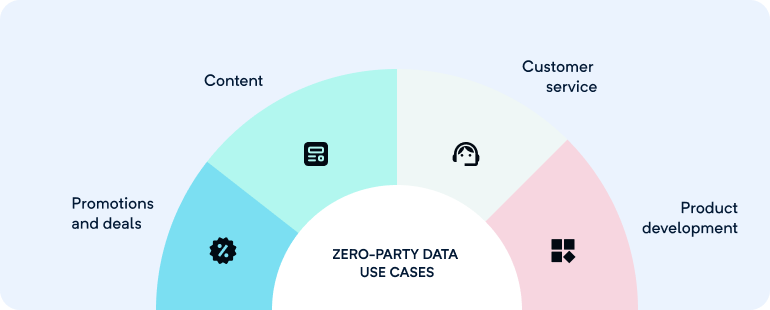
Chapter 5:
Future Predictions

As we look ahead, several emerging trends are set to shape the future of email marketing. These trends focus on leveraging advanced technologies and adapting to changing consumer expectations. Here are some of the most promising developments that marketers should prepare for.
5.1. The Rise of AI-Generated Content
Artificial Intelligence (AI) is transforming content creation across industries, and email marketing is no exception. AI-generated content is expected to grow significantly, with AI tools increasingly capable of creating personalized email copy, subject lines, and even visuals tailored to individual user profiles. This technology enables marketers to scale content production more efficiently while maintaining a high level of personalization.
How AI-Generated Content Works
AI tools like GPT (Generative Pre-trained Transformer) models can analyze vast amounts of data, including past email performance, user behavior, and demographic information, to generate content that resonates with individual recipients. These tools can create different versions of an email tailored to various audience segments, ensuring that each recipient receives the most relevant message.
For example, an AI tool might generate multiple subject lines for an email campaign, each designed to appeal to a specific segment based on their previous interactions with the brand. Similarly, AI can create email body content that is personalized to include product recommendations, special offers, or messages that align with the recipient's interests.
Benefits of AI-Generated Content
Scalability: AI allows for the rapid production of large volumes of content, making it easier to scale personalized email campaigns without requiring extensive manual effort.
Consistency: AI ensures that the tone, style, and quality of content remain consistent across all communications, reducing the risk of human error and enhancing brand voice.
Personalization: By analyzing user data, AI can create content that is highly personalized, increasing the relevance of email communications and improving engagement rates.
Challenges
While AI-generated content offers many benefits, it also presents challenges. One key concern is ensuring that AI-generated content remains authentic and aligns with the brand's voice. Additionally, over-reliance on AI could potentially lead to a lack of creativity or human touch in communications, which may affect how customers perceive the brand.
5.2. Voice-Activated Email Interactions
As voice technology continues to evolve, voice-activated email interactions are poised to become a significant trend. With the increasing adoption of voice assistants like Amazon's Alexa, Google Assistant, and Apple's Siri, users may soon be able to interact with their emails through voice commands, making email marketing more accessible and engaging.
How Voice-Activated Email Interactions Work
Voice-activated email interactions would allow users to perform actions such as reading emails, responding, or even navigating through content using voice commands. For instance, a user might ask their voice assistant to "read the latest email from [brand]" or "respond to this email with a confirmation." This interaction would be facilitated by integrating email platforms with voice recognition and natural language processing (NLP) technologies.
Benefits of Voice-Activated Email Interactions
Accessibility: Voice-activated interactions make email accessible to users who may have difficulty using traditional interfaces, such as individuals with visual impairments or those who prefer hands-free options.
Enhanced Engagement: By offering a new way to interact with emails, voice-activated technology can increase user engagement, particularly in scenarios where users might be multitasking or on the go.
Personalization: Voice technology can be used to deliver personalized content based on the user’s preferences and previous interactions, further enhancing the relevance of email communications.
Challenges
The primary challenge with voice-activated email interactions is ensuring accurate voice recognition and natural language processing. These systems need to be highly reliable to prevent errors in communication. Additionally, privacy concerns may arise as users interact with sensitive content through voice commands.
5.3. Sustainability in Email Marketing
As consumers become more environmentally conscious, sustainability in email marketing is gaining importance. Brands are increasingly focusing on reducing the carbon footprint of their email campaigns and promoting eco-friendly practices as part of their overall marketing strategies.
The Environmental Impact of Email
Every email sent, received, and stored requires energy, contributing to carbon emissions. While the impact of a single email may be minimal, the cumulative effect of billions of emails sent daily is significant. As awareness of environmental issues grows, consumers and companies alike are seeking ways to minimize this impact.
Sustainable Email Practices
Optimizing Email Design: By reducing the size of images and other media in emails, marketers can decrease the amount of data that needs to be processed and stored, thereby reducing the carbon footprint of their campaigns.
Targeted Campaigns: Focusing on highly targeted email campaigns reduces the number of unnecessary emails sent, ensuring that communications are relevant and impactful. This not only improves engagement but also reduces the overall volume of emails.
Green Messaging: Brands are beginning to include sustainability messages in their email communications, encouraging recipients to consider the environmental impact of their digital habits. This can also involve promoting sustainable products or initiatives.
Carbon Offset Programs: Some companies are exploring ways to offset the carbon emissions generated by their email marketing activities. This might involve investing in renewable energy projects or tree planting initiatives.
Challenges
mplementing sustainable email practices requires a shift in mindset and may involve upfront costs. Additionally, there is a need for greater awareness and education around the environmental impact of digital activities, both within organizations and among consumers.
Conclusion
As we move into 2025, the landscape of email marketing is rapidly changing. Marketers who embrace these trends—AI-driven personalization, interactivity, compliance with privacy regulations, and sustainable practices—will be well-positioned to succeed in the coming years. Staying informed and adapting to these shifts is crucial for maintaining a competitive edge.
